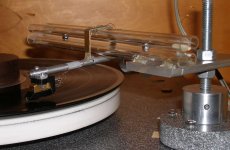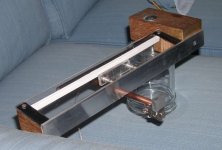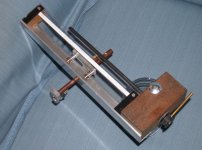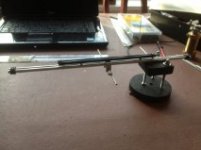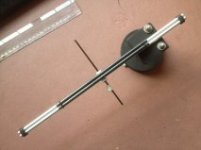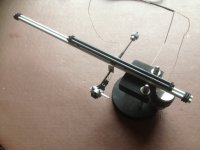Also need to arrange something to prevent the balls from taking off and exploring the living room floor. I like what I hear so far!
BillG
the performance is really good for being such a simple and "easy to do" concept.
Hi Bill
I'm very close to mounting my version of the arm and know exactly what you mean about 'errant ball bearings.' I've spent more than a few few minutes on my hands and knees recently. I think that when I've got the cartridge and counterweight on, they will tend to stay in situ (here's hoping) due to the extra mass (the carriage on its own only weighs about 12grams). Otherwise, I'll be ordering a bag full as spares!
Look forward to seeing pictures and mine will be up and running this week with a bit of luck.
Chris
I'm very close to mounting my version of the arm and know exactly what you mean about 'errant ball bearings.' I've spent more than a few few minutes on my hands and knees recently. I think that when I've got the cartridge and counterweight on, they will tend to stay in situ (here's hoping) due to the extra mass (the carriage on its own only weighs about 12grams). Otherwise, I'll be ordering a bag full as spares!
Look forward to seeing pictures and mine will be up and running this week with a bit of luck.
Chris
Hi Bill
I'm very close to mounting my version of the arm and know exactly what you mean about 'errant ball bearings.' I've spent more than a few few minutes on my hands and knees recently. I think that when I've got the cartridge and counterweight on, they will tend to stay in situ (here's hoping) due to the extra mass (the carriage on its own only weighs about 12grams). Otherwise, I'll be ordering a bag full as spares!
Look forward to seeing pictures and mine will be up and running this week with a bit of luck.
Chris
Hi Chris,
Yesterday I put crude prototype together out of stuff I had on hand and spent the evening listening to records. Used the ADC-XLM cart, 4 10mm glass tubes, an old junk 1/4" dia aluminum tube and some aluminnum plate to hold it all together and drop into the mounting stand for my 2 tube linear tracker. Pardon the lack of workmanship, it is all held together with CA and hot melt glue, a real mess! But performance wise it is an outstanding gem! Absolutely the cleanest sounding arm I have (not)heard. Those 2 balls in intimate contact with the tubes and with enough mass to keep it that way eliminate (imho) all additions or subtractions to the recorded signal. The transparency is amazing. What was that about hairs on the back of neck? Tracking is flawless so far.
Are you using smaller diameter tube/rod for the carriage? With my 10mm stardard weight tube I'm getting about 45 grams for the carriage alone. 61 grams for the whole carriage, cart/wand,cw. Tracking pressure is 1.6 grams. I'm not aware of any problems due to the heavier carriage weight.
Tracks like a champ. Put a small felt disk about .200 inches thick under a good record and let it play. That is a substantial warp. I was aware that the sound during the warp had something not right about it, but I couldn't detect any change in pitch wow. Listening to the "warped" record was clearly possible and not unpleasant. I think the 2 ball system recaptures the benefits of Colin's 4 bearing 1 tube design while eliminating multiple contact points and loose bearings etc. This design has 2 balls with 8 contact points total. The small ball bearings we have been using have 5 balls with at least 2 of them in contact with 2 races. That adds up to about 32 contact points for a 4 bearing 1 tube design. Maybe half that for a 2 bearing Cantus style arm. Going to try to include some pics now. Two of the pics are of the 2 tube 2 bearing design. The other one is the 2 ball design.
Rgds,
BillG
Attachments
Last edited:
Work In Progress
Hello Everyone
As you can see, I'm getting very close now. The base is quite clever (or so I think!) and is very stable-it also allows for easy adjustment. Final version will be more aesthetically pleasing. The wire you can see on the side of the mount is for holding the pick up wires. The cartridge will be mounted in the same way as I have done with my version of Colin's design. By the weekend-up and running and will then report back.
After hearing Bill's comments, I'm really looking forward to this one!
Regards
Chris
Hello Everyone
As you can see, I'm getting very close now. The base is quite clever (or so I think!) and is very stable-it also allows for easy adjustment. Final version will be more aesthetically pleasing. The wire you can see on the side of the mount is for holding the pick up wires. The cartridge will be mounted in the same way as I have done with my version of Colin's design. By the weekend-up and running and will then report back.
After hearing Bill's comments, I'm really looking forward to this one!
Regards
Chris
Attachments
It's amazing how three different designs of the same principle are coming together and seem totally unique in the approach. Glad to hear yours is sounding so good Bill. Are you going to turn it into something more permanent?
I like your cut down F1 approach Chris. I wondered about what the weight would do and how much strain it would place on the stylus tip but pleased to hear from Bills report that its able to cope. Had a busy weekend so couldn't take mine further yet but hope to get something sorted over the next few days
I like your cut down F1 approach Chris. I wondered about what the weight would do and how much strain it would place on the stylus tip but pleased to hear from Bills report that its able to cope. Had a busy weekend so couldn't take mine further yet but hope to get something sorted over the next few days
Steel Balls
Chris
- .Ebay has them as packs of ball bearings. I got 10 x 5mm for £1.99!
- Re Bill's design. I was surprised how well he says it works considering the mass of the carriage but I suspect it's a function of the lack of friction. My carriage without cartridge is around 12g and I think I may need more mass but I'll find that out when I mount the arm on the deck.
- I may also need to beef up the two rods for he carriage to run on. They seem rigid enough but again, I'l wait and see.
Chris
Hi all.
Unfortunately I'm far too tied up in a different kind of LT arm to experiment with this idea. The two ball design should give almost air bearing levels of friction so mass should not be an issue. In fact the opposite is probably true. The ladegaard air bearing design advocates very high mass with good theory to back this up. Even Bill's higher mass model might be a bit low. Filling the tubes with dry sand, WTL style, would add some needed mass as well as damping the tubes. Another thought I had was to add additional tube running from the ends of the armtube to the ends of the sliding rails creating a diamond shape. This would massively increase the overall rigidity of the carriage.
Niffy
Unfortunately I'm far too tied up in a different kind of LT arm to experiment with this idea. The two ball design should give almost air bearing levels of friction so mass should not be an issue. In fact the opposite is probably true. The ladegaard air bearing design advocates very high mass with good theory to back this up. Even Bill's higher mass model might be a bit low. Filling the tubes with dry sand, WTL style, would add some needed mass as well as damping the tubes. Another thought I had was to add additional tube running from the ends of the armtube to the ends of the sliding rails creating a diamond shape. This would massively increase the overall rigidity of the carriage.
Niffy
Another thought I had was to add additional tube running from the ends of the armtube to the ends of the sliding rails creating a diamond shape. This would massively increase the overall rigidity of the carriage.
Niffy
it sure does, I was planning on doing something similar to the tail but I run out of materials

Regards
- .Ebay has them as packs of ball bearings. I got 10 x 5mm for £1.99!
- Re Bill's design. I was surprised how well he says it works considering the mass of the carriage but I suspect it's a function of the lack of friction. My carriage without cartridge is around 12g and I think I may need more mass but I'll find that out when I mount the arm on the deck.
- I may also need to beef up the two rods for he carriage to run on. They seem rigid enough but again, I'l wait and see.
Chris
Hi Chris and Niffy,
Interesting thoughts re diamond shape etc. 2 wheels and a diamond frame, are you guys building a bicycle?
I've been thinking on a light weight very rigid wand configuration as well. For my gussied up 2nd generation of the 2 ball system I really think I will go back to Bo's 2 thin wall tubes spaced further apart at the back end. While the proposed hypotenuse from headshell to one end of the moving member will for sure stiffen things up, I suspect you are slaughtering mosquitoes with elephants. Give it a go anyhow.
Given my higher mass carriage (which may even be a bit on the light side) but will certainly give extra rigidity, and add a Cantus style arm wand methinks we will have an optimum design. Just when I was being convinced that a simple short CF or aluminum tube was all that was needed. (sigh)!
Rgds,
BillG
Hi Soyuz.
Has the addition of the single diagonal had an effect, positive or negative. Is it time to sacrifice TV for music and take your aerial to bits?
Bill.
The conceptual step from the cantus two rod to the diamond shape isn't a large one, in fact the cantus design gave me the idea in the first place. I believe the're are multiple advantage to the diamond configuration. Triangles are inherently more rigid than the trapezium of the cantus. The wider angle should hold the headshell much more solidly. Of course keep the arm tube short, that definitely hasn't changed. The upright headshell as used in colin's and your latest two rod arm should translate nicely to this design.
On the elephants and mosquito front, as the difference between a good arm and an excellent arm would be measured in fractions of a nanometer of headshell deflection everything that can make a difference will make a difference.
Niffy
Has the addition of the single diagonal had an effect, positive or negative. Is it time to sacrifice TV for music and take your aerial to bits?
Bill.
The conceptual step from the cantus two rod to the diamond shape isn't a large one, in fact the cantus design gave me the idea in the first place. I believe the're are multiple advantage to the diamond configuration. Triangles are inherently more rigid than the trapezium of the cantus. The wider angle should hold the headshell much more solidly. Of course keep the arm tube short, that definitely hasn't changed. The upright headshell as used in colin's and your latest two rod arm should translate nicely to this design.
On the elephants and mosquito front, as the difference between a good arm and an excellent arm would be measured in fractions of a nanometer of headshell deflection everything that can make a difference will make a difference.
Niffy
Soyuz,all,
This is quite a neat little design, I've been playing around with the concept a bit on this end. Nothing built here, but I do plan to try out the idea as its such a lovely simple idea. I'm seeing it differently though, I think the goal on this since it has massive tortional stability should be for an arm that clears the platter placing the tubes and bearing behind the platters edge rather than over the top. The lower lateral friction should allow this just fine, this would also make for a very clean looking and easy to change records arm .
.
Bill,
For tube damping just cut off a foam earplug, squish it up and place it into the end of each tube, incredibly effective at damping without changing the Q factor .
Colin
This is quite a neat little design, I've been playing around with the concept a bit on this end. Nothing built here, but I do plan to try out the idea as its such a lovely simple idea. I'm seeing it differently though, I think the goal on this since it has massive tortional stability should be for an arm that clears the platter placing the tubes and bearing behind the platters edge rather than over the top. The lower lateral friction should allow this just fine, this would also make for a very clean looking and easy to change records arm
Bill,
For tube damping just cut off a foam earplug, squish it up and place it into the end of each tube, incredibly effective at damping without changing the Q factor .
Colin
Last edited:
the Cantus is really a reference in this type of arm, if you use a very rigid material I think it can be made with just one rod as in the Clearaudio model, I got to admit that I've been lazy with this tonearm and I have not made any type of mods or testing in a long time, I just want to leave it alone and use my time instead for listening to music.Given my higher mass carriage (which may even be a bit on the light side) but will certainly give extra rigidity, and add a Cantus style arm wand methinks we will have an optimum design. Just when I was being convinced that a simple short CF or aluminum tube was all that was needed. (sigh)!
Rgds,
BillG
Hi Soyuz.
Has the addition of the single diagonal had an effect, positive or negative. Is it time to sacrifice TV for music and take your aerial to bits?
it did make it a little bit more stable although the change is more notable in warped records with better bass and overall focus is not massive but is definitely positive, in my case I think is not necessary to do the other side of the triangle , originally I was going to do a Cantus type of carriage with double tubing and triangular shape but I ended up using only one just for simplicity when it comes to adjusting and setting the cartridge, it worked great that way so I keep it and as I put it before I just wanted to play some music without too much hassle.
I think the goal on this since it has massive tortional stability should be for an arm that clears the platter placing the tubes and bearing behind the platters edge rather than over the top. The lower lateral friction should allow this just fine, this would also make for a very clean looking and easy to change records arm.
yes, that could make a very beautiful and sleek turntable, you are correct that the basic concept is very good in terms of stability but to obtain the full potential I think it will be mandatory to use very rigid materials ONLY or at least a good triangle geometry. short arms have the advantage when it comes to rigidity even in normal life we found this to be true, this is a very interesting quote from TNT-AUDIO:
[FONT=Arial, Helvetica]"The other characteristic shared with parallel trackers is that short and very stiff vestigial arm tube. There's a school of thought that the performance advantages of a parallel tracker are primarily down to this rather than 'perfect' alignment - if so the 507 has many of the parallel trackers advantages without the disadvantages."[/FONT]
the disadvantages he is talking about is for an air bearing design, complete document:
Dynavector 507 tonearm [English]
[FONT=Arial, Helvetica]"The other characteristic shared with parallel trackers is that short and very stiff vestigial arm tube. There's a school of thought that the performance advantages of a parallel tracker are primarily down to this rather than 'perfect' alignment - if so the 507 has many of the parallel trackers advantages without the disadvantages."[/FONT]
Hi all.
I'm definitely a member of this school of thought. Most of the colourations introduced by a tonearm are due to the bending modes of the arm tube that occur above its resonant frequency. By shortening the arm tube the resonant frequency is pushed to a much higher frequency leaving a wider portion of the audio bandwidth below this point. Additionally as the shorter arm tube is much more rigid the amplitude of the bending modes above the resonant frequency are also dramatically reduced. Even though the bass section of the music is below the resonant frequency with both long and short arms the shorter arm will still sound better. Imagine a bass instrument, its fundamental will be in the bass part of the audio spectrum. However the harmonics that give the instrument it character and timbre are spread over a much wider range. This is especially true for initial transients. (a similar principle to a super tweeter).
I would definitely recommend keeping the arm short. With my arm, as I've shown in Colin's excellent diy linear tonearm thread, I've attempted to take this a stage further by trying to push the arms resonant frequency out of the audio bandwidth entirely. Hopefully this will take colouration with it leaving me with a completely neutral arm.
The mechanical linear tracker is not without problems. The main one being the friction of the lateral bearings. This creates a side force on the cantilever that tends to push it away from remaining tangential to the groove. Worse still, as the arm tube does remain tangential, there is an associated misalignment of the cartridges generator. (overall I think the advantage of the short armtube massively out weighs this)
The two ball design would appear to have very little lateral friction but has more long tube sections. Whether one advantage outweighs the other is a really interesting part of this design.
Niffy
Niffy,
I am in agreement on the short arm, on my design I cannot pinpoint any sonic imprint as I could with a longer pivoted arm. I've been playing a little more with Soyuz design, besides the added mass of the moving tubes which can be made to be light, I notice lateral stability changing g a lot as it would traverse a record and the balls need to be precariously placed to avoid this across the playing surface of an lp. The main advantage with the radial bearings being fixed is that they are always in the same geometry with the arm center as it plays a record. To overcome this more substantial weight needs to be placed in line with the arms center to overcome any desire to place too much unequal load on any one ball, mass that far outweighs the outside masses of the sliding tubes or ćhannel.
Colin
I am in agreement on the short arm, on my design I cannot pinpoint any sonic imprint as I could with a longer pivoted arm. I've been playing a little more with Soyuz design, besides the added mass of the moving tubes which can be made to be light, I notice lateral stability changing g a lot as it would traverse a record and the balls need to be precariously placed to avoid this across the playing surface of an lp. The main advantage with the radial bearings being fixed is that they are always in the same geometry with the arm center as it plays a record. To overcome this more substantial weight needs to be placed in line with the arms center to overcome any desire to place too much unequal load on any one ball, mass that far outweighs the outside masses of the sliding tubes or ćhannel.
Colin
Nice job Chris, that looks great.
What length did you make each (top pair/bottom pair) of your tubes?
Dont know if I missed it but are the top pair Carbon Fiber?
Since all TV signals in this area are digital, finding a pair of rabbit ears
is just about impossible. I've searched everywhere....none to be found.
I did happen into a hobby shop the other day and to my surprise they sell
hundreds of different solid glass rods in all shapes and sizes. They're used for
glass art....making those small figurines from melted coloured glass. You should of seen the look on my face when I found them.....my wife laughed as I stood there and stared in amazement.
So I'm thinking of giving this arm a go using the glass rods as top and bottom rails.....but I also have some carbon fiber tube. Whats your guys thoughts?
just curious, as I'll probably try both.
What would you guys suggest as wand material.....I have both carbon fiber and aluminum tubing.
Thanks
Perry
What length did you make each (top pair/bottom pair) of your tubes?
Dont know if I missed it but are the top pair Carbon Fiber?
Since all TV signals in this area are digital, finding a pair of rabbit ears
is just about impossible. I've searched everywhere....none to be found.
I did happen into a hobby shop the other day and to my surprise they sell
hundreds of different solid glass rods in all shapes and sizes. They're used for
glass art....making those small figurines from melted coloured glass. You should of seen the look on my face when I found them.....my wife laughed as I stood there and stared in amazement.
So I'm thinking of giving this arm a go using the glass rods as top and bottom rails.....but I also have some carbon fiber tube. Whats your guys thoughts?
just curious, as I'll probably try both.
What would you guys suggest as wand material.....I have both carbon fiber and aluminum tubing.
Thanks
Perry
- Status
- This old topic is closed. If you want to reopen this topic, contact a moderator using the "Report Post" button.
- Home
- Source & Line
- Analogue Source
- My Linear Tracker (a new variation perhaps?)
